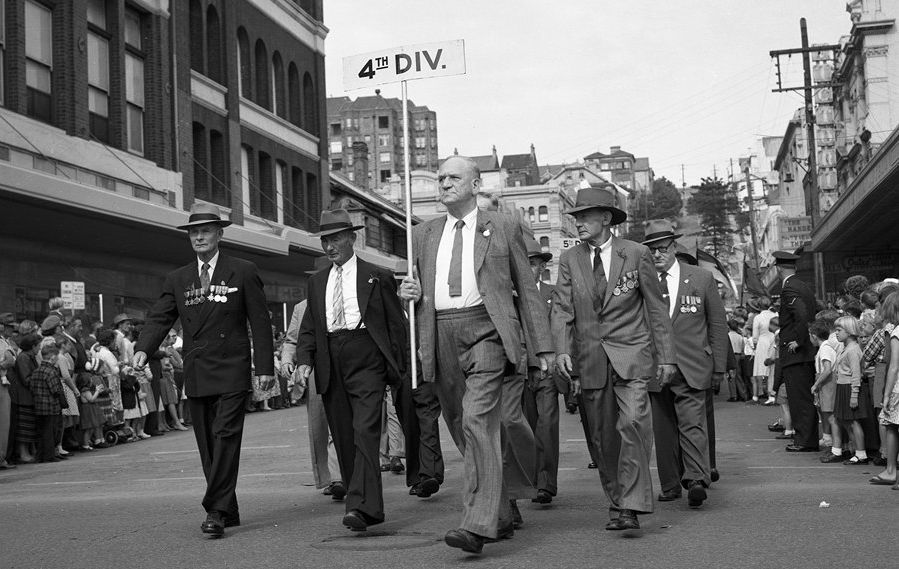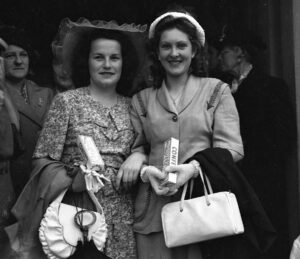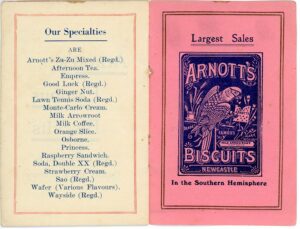From our book, The Hunter Region in The Great War
Most of the work of the returned services association in its early years was focused on supporting its direct constituency. But another major role was remembering and honouring the sacrifices and achievements of those who had fought and who were still fighting in a war whose scale and nature was without precedent.
From the moment that news arrived in Australia of the action at Gallipoli it was clear that this was an event with immense resonance. Australian families had sent thousands of their sons to fight battles of empire, and the bloodiness and difficulty of their first encounter invested the occasion with meaning for the nation. April 25, 1915, was a day that could not fail to be commemorated in Australia. Indeed, the first anniversary in 1916 was marked all over the country, and by Australian troops overseas.
In NSW the Returned Soldiers Association issued the NSW Anzac Memorial, which included a roll of honour, photographs and official documents relating to the Gallipoli landing. Its preface stated that:
The chief object of this Memorial is to record the names and deeds of Soldiers and Sailors of Australia and New Zealand; particularly of those who have fought, are fighting or will fight in the current ‘Liberation-War of Humanity’ from Germany’s Prussian threat of tyrannical domination.
The publishing Association is itself newly born; is not yet thoroughly organised for its principal work of establishing or re-establishing Returned Soldiers in efficient civil life.
Yet whatever defect of plan or haste of execution may be exhibited, it is thought well not to let pass this Glorious Anniversary of 25th April 1915 without an effort for literary commemoration.
Around Australia, people were animated by a similar desire to ensure this momentous date was remembered. In Newcastle the 1916 anniversary was a big event, marked by large crowds, a military procession and church services. The Newcastle Morning Herald reported that:
From early morning crowds thronged into the city from the suburbs and from the adjacent centres. Business was practically suspended during the forenoon, for major attention was devoted to the observances arranged by the committee, headed by the Mayor and the Returned Soldiers Association. But though crowds thronged the city streets, there was no appearance of carnival, rather was there an appropriate air of quiet reverence.
The services held in churches of all denominations after the military procession were very largely attended. A great many of the shops and other business places, as well as vehicles were draped in black and purple and there was also a free display of bunting, all flying at half-mast, and in which the public offices and the ships in the port participated. The returned soldiers were greeted with lusty cheering, which was redoubled in honour of a number, not sufficiently recovered to be able to walk, and a couple of whom were blind, who were conveyed in motor cars.


A gun was fired at midday from Fort Scratchley, a band played the national anthem and a gathering at the Gardner Memorial outside Newcastle Post Office witnessed the laying of a large number of floral wreaths.
Returned servicemen remained at the forefront of Anzac Day observance over the ensuing years. By 1921 the parade in Newcastle numbered 850, with 350 of them returned men. A commemorative service in Christ Church Cathedral drew more people than the church could hold. The dean of the cathedral, the Very Rev. H. Crotty, “thanked God for the hold that Anzac Day had got on the Australian people”. It was “the greatest day in our Australian calendar” and “must ever be kept as a day of holy memories”. Australians should keep Anzac Day as men kept their birthdays, as the “day of Australia’s new birth”.
Rev. Crotty told his congregation that when he was in France “as he saw good men die” he had wondered “whether out of all the terror and the horror we were going to snatch anything, weave anything lasting and beautiful to wrap around the soul of man”.
A great betrayal of the slain
He remembered hoping so, but found in Australia in 1921 “indifference and inertia, folly and indiscipline, riot and extravagance”. The “demagogue, the partisan and the parasite” were “still unchallenged, still enthroned in our Australian life”. This amounted, he charged, to a “great betrayal of the slain”.
When the City of Newcastle Sub-branch of the RSSIL held its annual meeting in 1923, the executive “hoped that as time went on Anzac Day would become an institution definitely established in the Newcastle district” as “the Returned Sailors and Soldiers national day”.
“Though not a public holiday, the league had now definitely established Armistice Day as Poppy Day and the best thanks of the league were due to the Mothers, Wives and Widows Association for their assistance with the disposal of poppies on that day.”
Armistice Day was then, and would be for many years to come, a major day of remembrance and commemoration, marking not any particular deeds of arms but instead recalling the end of a long and horrific conflict.
By 1923 Anzac Day was being observed across NSW as a public holiday. In Newcastle the larger shops were closed, as were schools and government offices. The league-organised march of returned service people started at the sub-branch’s Perkin Street headquarters at 10am, going by way of Hunter Street, Bolton Street and Church Street to the cathedral, with non-Anglicans breaking off on the way to attend services at their own churches. After the church services, the march reconvened and formed up at the Gardner Memorial. A concert was held at King’s Hall in the evening.
In 1927 Anzac Day in Newcastle was marked by the closure of hotels – by Government decree – from 10.30am to 1pm, and the district’s colliery owners closed their mines for the period. Flags flew at half-mast across the city and quiet crowds watched the league-organised march before piling banks of wreaths around the Gardner Memorial.


King Edward Park became the focus of Anzac Day in Newcastle City in 1929, which was said to be the biggest commemoration of its type in the city since the observance began. Members of the police force, of the scouting and guides movement and many other organisations joined in the parade. Several thousand people attended the combined service in the park, where sermons spoke of the importance of promoting peace rather than glorifying war, and of the need to take more care of returned Diggers.
The pattern was set for years to come, with observances split between the Gardner Memorial and King Edward Park. In the 1930s, when times were tough, unemployed Diggers had their transport costs to the services covered by the public purse or the generosity of bus companies.
The 1935 commemoration – marking the 20th anniversary of the Gallipoli landing – was predictably huge. Hundreds of Hunter returned service people caught special trains to Sydney where the biggest march took place. In Newcastle there was controversy when the city’s trams kept running during the service outside Newcastle Post Office, spoiling the solemnity of the Last Post and the two-minute silence. Only one driver, of his own volition, stopped his vehicle during the laying of wreaths on the Gardner Memorial. This was in contrast to Sydney, where police stopped all traffic for the duration.
In 1945 Anzac Day was eclipsed by the celebrations in May that marked the end of the war in Europe. An enormous crowd turned out to witness a parade of British Marines and a march by members of the Newcastle Sub-branch of the RSL who laid a wreath on the Gardner Memorial in thanksgiving for victory over Hitler. The celebrations that followed the defeat of Japan in August 1945 were even bigger. But also in 1945 it had become apparent that the now-traditional Anzac Day march to King Edward Park was a taxing effort for many ageing Diggers. A push began to restrict the march to flatter ground, finishing at the sportsground in Parry Street, Newcastle West. This plan was adopted in 1946.


The creation of more and more RSL sub-branches in the Newcastle district meant a wider range of Anzac Day commemorations. The Civic Sub-branch’s Dawn Service at the soldier memorial in Gregson Park, Hamilton – the first of which was held in 1941 – was a notable and well-attended example.
By 1946 the Diggers of World War I were joined – and indeed outnumbered – by returned service people from World War II, which had ended in August 1945 when atomic bombs were dropped on Japan. More than 5000 people attended the 1946 Dawn Service in Gregson Park, and 5500 went to Newcastle’s united service at the city’s No 1 Sportsground. The June 1946 celebration of Victory Day in Newcastle was another tremendous show of support for returned servicemen, especially those who had served in World War II, and this occasion brought a return to King Edward Park as the favoured site for such commemorations.
Indeed, by 1947 the RSL took Anzac Day back to King Edward Park, arguing that No 1 Sportsground wasn’t really suitable. “The sincerity and solemnity of the service in the gift of natural beauty at King Edward Park was lacking at the Sportsground,” the league declared.
Also in 1947 a Newcastle branch of the Gallipoli Legion of Anzacs was formed, and about 80 members of this group marched on Anzac Day in the city for the first time.
In 1948 the number of wreaths laid on the Gardner Memorial set a record, but fewer ex-servicemen marched in the Anzac Day procession. It was again speculated that the uphill route to King Edward Park was dissuading some from making the effort. Also in 1948 Armistice Day was renamed, by royal decree, to “Remembrance Day”, a gesture designed to encompass the memory of both world wars. Few people attended the ceremony at the Gardner Memorial, however, prompting the secretary of the Newcastle Sub-branch, Mr F. Keen, to deplore the apathy of the community.
“It speaks volumes for the apathy of the people, and ex-servicemen in general, when they can’t turn out for less than 10 minutes to pay tribute to the men who fought and died for them,” Mr Keen lamented.
In 1950 the Newcastle district RSL sub-branches decided to oppose a suggestion that the Anzac Day service be again shifted from King Edward Park. This time the proposed alternative was Civic Park where moves were afoot to erect a cenotaph as part of the new cultural centre precinct. The RSL declared that any men too ill to march up the hill could be easily accommodated in cars.



The 1950 Anzac Day march in Newcastle was one of the biggest ever to that point, with about 3500 marchers and more than 20,000 spectators lining the length of Hunter Street about five deep. Many World War I men, however, declined to attempt the climb up Watt Street from the Gardner Memorial to King Edward Park, prompting more soul-searching about the proper location for the culminating service.
At the same time, efforts were being made to shift the Dawn Service, traditionally held at Gregson Park, to Civic Park. To the annoyance of some this move was ratified.
In a bid to keep the march to King Edward Park, in 1951 the Newcastle Sub-branch changed the route, avoiding the onerous direct Watt Street climb. Organisers agreed to slow the pace of of the march. By this time Korean War veterans had begun to join the returned men from the world wars.
With the disbanding of the Civic Sub-branch of the RSL, which had previously organised the Gregson Park Dawn Service, the newer arrangement of having the Newcastle District Council run the Dawn Service in Civic Park became entrenched.
Other sub-branches ran their own Dawn Services and other Anzac Day activities in their own areas, and many of these attracted very significant followings.
In the year 2000, the City of Newcastle Sub-branch moved its Dawn Service from Civic Park to the harbour foreshore area near Nobbys Beach, a shift that has proven to be extremely popular.
City of Newcastle Sub-branch President Ken Fayle writes:
During the 1980s and 90s, whilst the Newcastle District Council of RSLs was responsible for organising Anzac Day and Remembrance Day services in Newcastle City, the Anzac Day Committee was mostly made up of members of the City of Newcastle Sub-branch.
Because of poor attendances at the Anzac Dawn Service in Civic Park, it was decided to transfer the year 2000 Anzac Dawn service to Nobbys Beach to celebrate the turn of the century. Despite a lot of criticism from some quarters a crowd of more than 1500 people gathered at Nobbys, almost three times the average attendance for Civic Park. Through the next 14 years the attendance steadily increased with 20,000 people attending in both 2013 and 2014 despite, on many occasions, having to endure wet and windy weather.
By this time NBN Television had become a major supporter of the Anzac Day committee of the sub-branch which had, with the agreement of the District Council, become the official organiser of all Anzac Day activities in the Newcastle CBD. NBN provided cameras to telecast the Service directly onto large LED screens which enabled all attendees a good view from any part of the park. We had great support from Newcastle City Council and a number of commercial and private donors. Transport NSW provided extra trains, buses and ferries and Hunter TAFE provided students as volunteers to help at events.
We felt confident we could achieve a record crowd of 30,000 people at the Dawn Service in 2015, but the official count for attendance was 55,000, nearly three times the crowd in 2014. What made the attendance more amazing was that the entire area of Greater Newcastle had been subject to a huge storm just four days earlier with damage throughout the entire region. Due to the success of the 2015 Dawn Service, NBN Television decided to direct telecast the 2016 event to their entire broadcast area, from Gosford in the south to the Gold Coast in the north and west past Moree.
In 2016 the crowd dropped to a touch over 40,000 people, with another 20,000 people watching the Newcastle Anzac Dawn Service live on NBN. Another 2000 hits in 38 countries were recorded on the YouTube Live channel.
In 2014, with the help of a grant from the NSW Government and the Newcastle City Council the sub-branch built the Newcastle Anzac Flame which is lit and burns at the site of the Dawn Service and Nobbys. This is a place for those who wish to remember in their own, private time, but which then becomes the focal point of the Anzac Dawn Service.
In 2015, the Australian Army Band Newcastle, combined with the City of Newcastle RSL Pipe Band, performed a traditional Sunset Service on the city’s new Anzac Memorial Walk. This service, as well as the lighting of the Anzac Flame, will now become permanent events in the city leading up to Anzac Day.
The evening before Anzac Day, a Candlelight Vigil is held in the Memorial Grove in Civic Park. All these events are designed to allow people to attend and commemorate the fallen in their own way, in their own time. The City of Newcastle RSL Sub-branch is proud to offer these services to the community.
Since 2000, despite a few wet days, the Anzac Day March has continued to grow, as has the crowd that attends the United Commemorative Service in Civic Park. The crowds at all the events are made up of younger people which suggests that the efforts of all people who have served in the Australian Defence Forces in many different theatres, either in war, peacekeeping and peacemaking activities, are appreciated.



